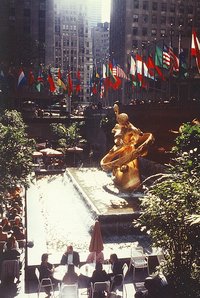Rockefeller Center
|
|
Rockefeller Center is a complex of 19 commercial buildings between 48th and 51st street in New York. It's located in the center of Midtown Manhattan, straddling both Fifth Avenue and Sixth Avenue. Today's Rockefeller Center is essentially a combination of two building complexes: the older Art-Deco office buildings from the 1930s and a set of four International-style towers built along the Avenue of the Americas during the 1960s and 1970s.
Rockefeller Center was named after John D. Rockefeller Jr. who leased the space from Columbia University in 1928 and developed it between 1929 and 1940. Rockefeller initially planned to build an opera house on the site, but changed his mind after the stock market crash of 1929. Construction of buildings in the Art Deco style began in 1929. Principle architect for the complex was Raymond Hood, working with a team that included a young Wallace Harrison.
GEBuilding.jpg
The nation's largest indoor theater, Radio City Music Hall, is located in the Rockefeller Center complex. One of the complex's first tenants was The Radio Corporation of America, hence the names "Radio City" and "Radio City Music Hall."
The centerpiece of Rockefeller Center is the 71-floor, 872-foot RCA Building, centered behind the sunken plaza. It was renamed the GE Building in the 1980s after General Electric (GE) acquired RCA. Unlike most other Art Deco towers built during the 1930s, the GE Building was constructed as a slab with a flat roof. The entire Rockefeller Center complex was purchased by a Mitsubishi subsidiary in the 1989.
Among other public art in the complex, Paul Manship's highly recognizable gilded statue of Prometheus recumbent, bringing fire to mankind, features prominently. It stands above a below-level plaza which is used as an ice-skating rink during winter. Manship was not fond of it. Sculptor Lee Lawrie contributed a number of friezes and the statue of Altas. Mexican socialist artist Diego Rivera had been commissioned to create a mural for the center, but Man at the Crossroads was removed soon after completion because it contained a portrait of Lenin and other anti-Rockfeller imagery.
Writer and New York Times omsbudsman Daniel Okrent wrote "Great Fortune : The Epic of Rockefeller Center" in 2003.
RockefellerCenterRinkTree.JPG
See also
External link
- Rockefeller Center Webcam (http://www.wnbc.com/wxcam/1210190/detail.html)
- Rockefeller Center homepage (http://www.rockefellercenter.com/home.html)
de:Rockefeller Center he:מרכז רוקפלר fr:Rockefeller Center pt:Rockefeller Center

